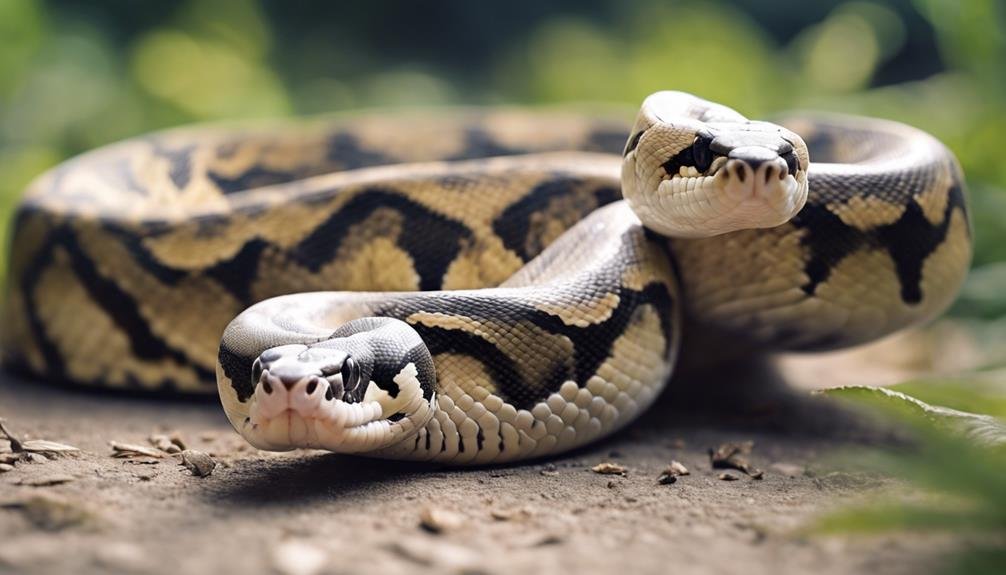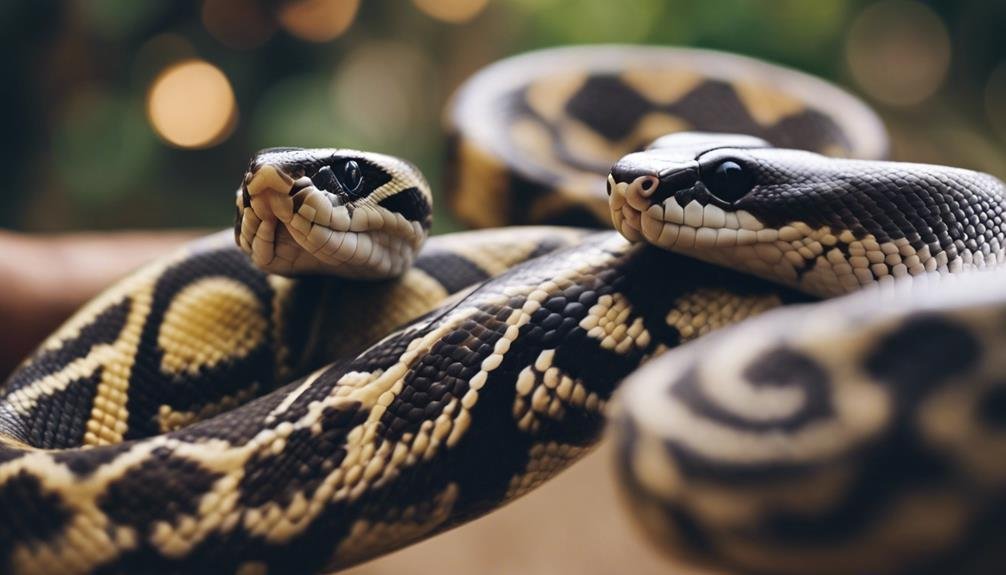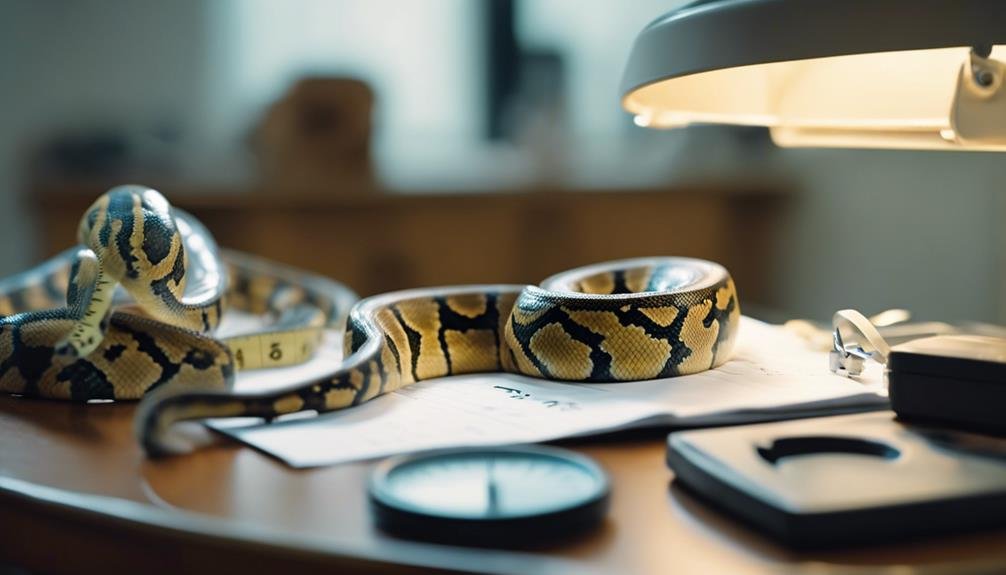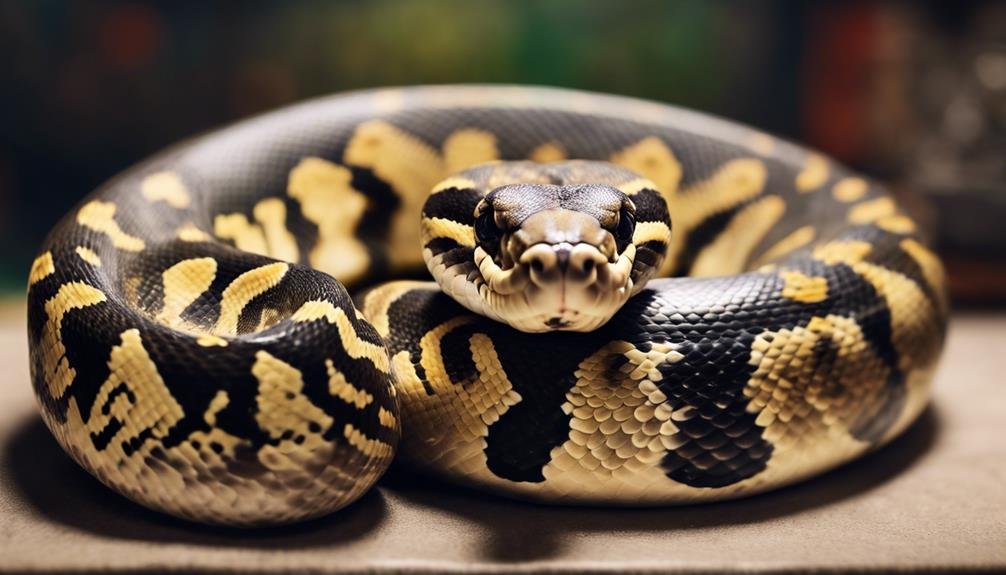When you're considering bringing a ball python into your home, understanding their growth milestones—age, weight, and size—is essential. You've likely heard that males and females differ significantly in size, with females generally outpacing males in both length and weight. But did you know that factors like genetics, diet, and environment play pivotal roles in their development? If you're curious about how to guarantee your ball python reaches its full potential in a healthy manner, or if you're simply intrigued by the variations in growth among these fascinating creatures, there's much more to explore. What might seem like minor differences can have a significant impact on their overall well-being.
Key Takeaways
- Full-grown male ball pythons reach 2-3 feet in length and weigh 2-3 pounds, while females grow to 4-5 feet and around 5 pounds.
- The growth rate slows considerably after the first three years, with females growing 12-16 inches per year and males at 8 inches per year.
- Proper husbandry, including diet and enclosure size, is crucial for reaching healthy adult sizes and preventing obesity.
- Environmental factors and genetics play significant roles in determining the potential size and growth rate of ball pythons.
- Regular weighing and monitoring are essential to track growth, detect potential health issues, and adjust care as needed.
Understanding Growth Milestones
To understand your ball python's development, it's important to recognize key growth milestones they'll hit from hatchling to adulthood. Initially, juvenile growth is rapid, with your snake doubling its weight by around 3 months old. This early weight gain is essential for reaching their full potential size. By their first birthday, juveniles should measure 16 to 24 inches long, indicating they're on the right track.
Entering the sub-adult stage, from 1 to 3 years old, your ball python continues its growth journey but at a slower pace, typically gaining 300 to 500 grams per year. This continuous growth is crucial for them to achieve their adult size. It's a positive sign of health and wellbeing, showing that they're developing as expected.
Adult Size and Weight
Reaching adulthood, ball pythons exhibit significant differences in size and weight between males and females. The adult size and weight of these creatures are influenced by their growth rate, which varies distinctly between genders. A male ball python, for instance, typically reaches a length of 2-3 feet and weighs about 2-3 pounds. In contrast, females grow larger, reaching lengths of 4-5 feet and a weight of around 5 pounds. This disparity in size is not just a matter of length but also girth, as females develop a more pronounced triangular shape around the thickest part of their bodies, indicative of their readiness for reproduction.
The growth rate is another area where males and females differ. Males grow at a rate of approximately 8 inches per year, while females can surge ahead with a growth rate of 12-16 inches per year. By the time they're 3 years of age, females can reach their maximum length of 4-5 feet, whereas males will typically measure between 2.5-3.5 feet in length. Post three years, the growth rate for both sexes slows considerably.
| Age (Years) | Male Length (Feet) | Female Length (Feet) |
|---|---|---|
| Up to 3 | 2.5 – 3.5 | 4 – 5 |
| Adult Weight | 2 – 3 lbs | ~5 lbs |
| Growth Rate | 8 inches/year | 12-16 inches/year |
Factors Influencing Growth


Understanding the factors that influence growth is key to ensuring your ball python reaches its full size and maintains peak health. Genetics play a foundational role in determining the potential size and growth rate of your ball python. Not all pythons are created equal, and their genetic blueprint greatly impacts their adult size and weight.
Temperature variations within their enclosure can also notably influence their growth. Proper husbandry practices, ensuring a gradient of warmth, mimic their natural habitat and facilitate proper digestion and metabolism, which in turn supports healthy growth. The size of the enclosure matters too; ample space supports physical activity, which is important for overall well-being and growth.
Your ball python's feeding schedule, including the type and size of prey, directly affects its growth and weight. Overfeeding or underfeeding can lead to health issues affecting growth, so it's crucial to find a balance. Regular monitoring of weight and girth helps in tracking growth and adjusting care as needed.
Gender differences can't be overlooked; typically, females grow larger than males, influencing the expectations for adult size. By understanding and managing these factors, you're on the right path to supporting your ball python's growth throughout its life.
Recognizing Weight Issues
Identifying weight issues in your ball python is essential for guaranteeing its health and longevity. Obesity can be spotted when your snake exhibits a circular appearance, with bulging sides, overstretched scales, and visible fat deposits indicating it's carrying extra weight. Keeping an eye on your ball python's body condition is vital; a healthy snake should maintain a somewhat triangular shape, not rounded.
To combat and prevent weight problems, providing an appropriately sized enclosure equipped with climbing branches can encourage your snake to move more, promoting a healthier weight. Adjusting feeding schedules and prey sizes according to your python's current weight is another effective strategy for managing its health. Regular monitoring and adjustments ensure that your ball python isn't overfed or given prey that's too large, both of which can lead to obesity.
Maintaining these healthy habits, including balanced diets, consistent feeding routines, and suitable prey sizes, is pivotal in preventing obesity. By closely observing your ball python's body condition and making necessary adjustments to its care, you'll help guarantee a long, healthy life for your pet.
Common Growth Challenges


Ball Pythons often face growth challenges that can range from slow growth rates to irregular development patterns. These challenges are influenced by several factors, including genetics, your feeding schedule, and the environmental conditions you provide. It's not uncommon for ball pythons to go through growth spurts, where they rapidly increase in size, only to hit plateaus where their growth seems to stall. This pattern can be perplexing, leading you to wonder if you're doing something wrong.
Inadequate nutrition is a key suspect when it comes to stunted growth in ball pythons. If you're not offering a diet that meets their specific needs, it could greatly impact their development. Similarly, incorrect husbandry practices, such as maintaining improper temperature or humidity levels, can create growth challenges. These environmental factors play an important role in how well your ball python thrives.
To tackle these growth challenges, it's vital to monitor not just their weight and size, but their overall health. Adjusting their feeding schedule, ensuring their diet is nutritionally complete, and fine-tuning their environmental conditions can help your ball python overcome these hurdles. Remember, each snake is unique, and what works for one may not work for another.
Unique Variations in Size
While it's important to address common growth challenges, it's equally essential to recognize the remarkable size variations that exist among ball pythons. You might be surprised to learn that some male ball pythons can stretch up to 5 feet in length, and females can even grow to 6 feet. These sizes exceed what you'd typically expect, highlighting the unique nature of these creatures.
Outliers in the ball python population can reach sizes beyond the average for their gender, creating a fascinating diversity within the species. For instance, while older females may tip the scales close to 3,000 grams, larger males can weigh around 1,500 grams. This showcases not just length but weight variations as well.
Monitoring weight is essential. It helps you prevent overfeeding, ensuring your python's proper growth and health. Understanding these size and weight variations is key to managing their care effectively. By tailoring feeding schedules to accommodate their unique needs, you'll contribute significantly to their overall well-being. Remember, every ball python is different, and recognizing these variations will help you provide the best care possible.
What is the average size and weight of a full grown ball python, and how does it relate to their lifespan?
The average size of a full grown ball python is around 4-5 feet in length, while their weight typically ranges from 3-5 pounds. This size and weight are directly related to their lifespan, as ball python lifespan secrets reveal that a healthy adult can live for 20-30 years in captivity.
Monitoring and Measurement Tips


To guarantee your ball python's health and growth are on track, it's important to regularly monitor and accurately measure its size and weight. Using a scale with a platform of at least 6 inches square is essential for obtaining accurate weight measurements. Make sure the scale can measure a range from 50 to 6,000 grams to accommodate your python's weight changes over the years. Always zero the weight of the container before placing your snake on the scale to make sure the reading reflects only your python's body weight.
When your ball python balls up after being removed from its enclosure, it's the best time to weigh it for a more stable measurement. This behavior can help you get a more accurate reading since they tend to be more stationary in this position.
| Measurement Tip | Why It's Important |
|---|---|
| Use a large enough scale | Ensures accurate weight measurements throughout your python's life |
| Zero the container's weight first | Guarantees the reading reflects only the python's body weight |
| Weigh when balled up | Provides a more stable and accurate measurement |
Monitoring your ball python's growth and size through careful measurements is key to ensuring its health and well-being over the years.
Conclusion
So, you've learned that a full-grown ball python's size and weight can vary, depending on several factors.
It's important to monitor their growth and watch for any unusual weight issues, as these can be signs of health problems.
Whether you've got a male or female, understanding their unique growth patterns helps make sure they're thriving.
Remember, keeping an eye on their development, and providing proper care, means you're on the right track to raising a healthy, happy ball python.


